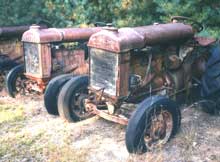Henry Ford’s interest in self-propelled vehicles was partially born of his dislike for farm work. It’s no surprise, then, that after putting America on wheels with an inexpensive passenger car, the Model T Ford, he started to build tractors. In 1917, with his son Edsel he founded a new company, Henry Ford & Son, which produced its first gasoline-powered tractor toward the end of the year. The name “Fordson” was chosen for the new machine because another party was already building Ford tractors in Minnesota. Ford knew there would be a ready market for his tractor as several aftermarket entrepreneurs were already selling conversion kits for Model Ts.
The Fordson Model F followed Model T practice in having an L-head four-cylinder engine, at 251 cubic inches about 40 percent larger than the T powerplant. It used thermosyphon cooling, a gravity feed fuel tank located over the engine, a low-tension flywheel-mounted magneto with trembler coils, the latter mounted in a box on the left side of the engine. It was the first tractor to use engine and transmission castings as the vehicle’s chassis. The Fordson departed from Model T practice, though, in having a sliding gear transmission with a multiplate clutch rather than a planetary drive train. Initially there were no brakes, but in 1923 a transmission-mounted multiplate brake was added. A high-tension magneto was a popular aftermarket accessory, as was a water pump. Fordsons were manufactured at Dearborn and later at the River Rouge plant until 1928.
Ironically, the Fordson had a longer life abroad. Manufacture was initiated at Cork, Ireland, in 1919, and continued until 1932, at which time Ford’s new English plant at Dagenham, Essex, took over. A new model, the N, was introduced in 1928, with a larger bore engine, high-tension magneto, water pump and axle brakes. This continued in production until the end of World War II.
Whereas in America Ford tractors had experienced a hiatus from for more than ten years until the all-new 9N Ford tractor was introduced in 1939, in Britain there was no letup. At war’s end, further updates were introduced on the E27N Fordson Major, still very much a Fordson but with a higher stance, single-plate oil-filled clutch, optional electric starting and lighting, and hydraulic drawbar. A six-cylinder Perkins diesel engine became available in 1948. The E27N remained in production until replaced by the E1A New Fordson Major in 1952. Thus the Model T of tractors, which had lasted barely a decade in the United States, managed a 33-year run abroad.

